Transdiagnostic Assessment of Temporal Experience (TATE) in Mental Disorders—Empirical Validation and Adaptation of a Structured Phenomenological Interview
Abstract
:1. Introduction
2. Materials and Methods
2.1. TATE Structure
2.2. Adaptation and Validation Procedure
3. Results
3.1. Translation and Expert Panel
3.2. Face Validation of TATE PL v.1
3.2.1. Face Validation Procedure
- Do you understand the prompt?
- Explain how you understand the prompt. What do you think the prompt says?
- Can you reformulate it to be more understandable if you do not understand it?
3.2.2. Face Validation Results
3.3. Quantitative Testing of TATE PL v.2
3.3.1. Quantitative Testing Procedure
3.3.2. Quantitative Testing Sample
3.3.3. Quantitative Testing Data Exploration
3.3.4. Quantitative Testing Correlations
3.4. Further Modifications of TATE PL
3.4.1. Premises
3.4.2. New Introduction
- How, normally, does time pass for you?
- 2.
- How important is time in your life?
3.4.3. Rearrangement of Items
- 1.
- Routine (6.l, 6.i, 6.a)—the items in this set are related to the everyday passage of time, allowing the interviewer to refer to the answers for the introductory questions;
- 2.
- Plans (7.c, 6.b, 6.g);
- 3.
- Goals and responsibilities (6.e, 6.d, 6.j, 6.f, 3.e, 6.c, 7.a);
- 4.
- Memories (5.c, 5.f, 5.e);
- 5.
- Deceleration (6.m, 3.b, 3.f, 3.d);
- 6.
- Acceleration (3.a, 4.c);
- 7.
- Disintegration (3.c, 2.a, 2.b, 4.a, 4.b, 6.n, 6.h, 5.d);
- 8.
- Confusion (1.b, 1.c, 1.a, 2.c, 6.k);
- 9.
- Negative temporal feelings (5.a, 5.b, 7.b, 7.d, 7.g);
- 10.
- Alertness (7.f, 7.e);
- +
- Open-ended question.
3.4.4. Revision of Items
3.4.5. Expert Approval
4. Discussion
4.1. Summary of the Validation Procedure
4.2. Punishment Problem
4.3. Administration of TATE PL
4.4. Enhancement of Phenomenological Research Tools
4.5. Broader Significance
4.6. Conclusions
Supplementary Materials
Author Contributions
Funding
Institutional Review Board Statement
Informed Consent Statement
Data Availability Statement
Acknowledgments
Conflicts of Interest
References
- Von Gebsattel, V.E.F. Von Zeitbezogenem Zwangsdenken in Der Melancholic. Nervenarzt 1928, 1, 275–287. [Google Scholar]
- Straus, E. Das Zeiterlebnis in Der Endogenen Depression Und in Der Psychopathischen Verstimmung. Eur. Neurol. 1928, 68, 640–656. [Google Scholar] [CrossRef]
- Straus, E.W. Disorder of Personal Time in Depressive States. South Med. J. 1947, 40, 254–259. [Google Scholar] [CrossRef] [PubMed]
- Minkowski, E. Le Temps Vécu; d’Arey: Paris, France, 1933. [Google Scholar]
- Binswanger, L. Das Raumproblem in der Psychopathologie. Z. Gesamte Neurol. Psychiatr. 1933, 145, 598–647. [Google Scholar] [CrossRef]
- Binswanger, L. Melancholie und Manie; Phänomenologische Studien: Pfullingen, Germany, 1960. [Google Scholar]
- Bech, P. Depression: Influence on Time Estimation and Time Experience. Acta Psychiatr. Scand 1975, 51, 42–50. [Google Scholar] [CrossRef] [PubMed]
- Kimura, B. Ecrits de Psychopathologie Phénoménologique; PUF: Paris, France, 1992. [Google Scholar]
- Kobayashi, T. Melancholie und Zeit; Stroemfeld: Basel, Switzerland; Frankfurt, Germany, 1998. [Google Scholar]
- Van Beek, W.; Berghuis, H.; Kerkhof, A.; Beekman, A. Time Perspective, Personality and Psychopathology: Zimbardo’s Time Perspective Inventory in Psychiatry. Time Soc. 2011, 20, 364–374. [Google Scholar] [CrossRef]
- Ratcliffe, M. Varieties of Temporal Experience in Depression. J. Med. Philos. 2012, 37, 114–138. [Google Scholar] [CrossRef] [PubMed]
- Sass, L.; Pienkos, E. Space, Time, and Atmosphere a Comparative Phenomenology of Melancholia, Mania, and Schizophrenia, Part II. J. Conscious. Stud. 2013, 20, 131–152. [Google Scholar]
- Borda, J.P. Self over Time: Another Difference between Borderline Personality Disorder and Bipolar Disorder. Eval. Clin. Pract. 2016, 22, 603–607. [Google Scholar] [CrossRef]
- Stanghellini, G. Abnormal Time Experience, Bizarre Delusions and Verbal-Acoustic Hallucinations in Schizophrenia. Eur. Psychiatr. 2016, 33, S32. [Google Scholar] [CrossRef]
- Moskalewicz, M. Toward a Unified View of Time: Erwin W. Straus’ Phenomenological Psychopathology of Temporal Experience. Phenomenol. Cogn. Sci. 2018, 17, 65–80. [Google Scholar] [CrossRef]
- Moskalewicz, M. Temporal Delusion: “Duality” Accounts of Time and Double Orientation to Reality in Depressive Psychosis. J. Conscious. Stud. 2018, 25, 163–183. [Google Scholar]
- Vogel, D.H.V.; Krämer, K.; Schoofs, T.; Kupke, C.; Vogeley, K. Disturbed Experience of Time in Depression—Evidence from Content Analysis. Front. Hum. Neurosci. 2018, 12, 66. [Google Scholar] [CrossRef] [PubMed]
- Fuchs, T. Melancholia as a Desynchronization: Towards a Psychopathology of Interpersonal Time. Psychopathology 2001, 34, 179–186. [Google Scholar] [CrossRef] [PubMed]
- Fuchs, T. Psychopathology of Depression and Mania: Symptoms, Phenomena and Syndromes. J. Psychopathol. 2014, 20, 404–413. [Google Scholar]
- Alonso-Fernandez, F. Space and Time for the Manic Person. In Phenomenology and Psychiatry; de Koning, A.J.J., Jenner, F.A., Eds.; Grune & Stratton: New York, NY, USA, 1982. [Google Scholar]
- Binswanger, L. On the Manic Mode of Being-in-the-World. In Phenomenology: Pure and Applied; Straus, E.W., Ed.; Duquesne University Press: Pittsburgh, PA, USA, 1964; pp. 127–141. [Google Scholar]
- Gruber, J.; Cunningham, W.A.; Kirkland, T.; Hay, A.C. Feeling Stuck in the Present? Mania Proneness and History Associated with Present-Oriented Time Perspective. Emotion 2012, 12, 13–17. [Google Scholar] [CrossRef] [PubMed]
- Bowden, H. A Phenomenological Study of Mania and Depression. Ph.D. Thesis, Durham University, Durham, UK, 2013. [Google Scholar]
- Moskalewicz, M.; Schwartz, M.A. Temporal Experience in Mania. Phenomenol. Cogn. Sci. 2020, 19, 291–304. [Google Scholar] [CrossRef]
- Pazzagli, A.; Monti, M.R. Dysphoria and Aloneness in Borderline Personality Disorder. Psychopathology 2000, 33, 220–226. [Google Scholar] [CrossRef]
- Stanghellini, G.; Rosfort, R. Borderline Depression a Desperate Vitality. J. Conscious. Stud. 2013, 20, 7–8. [Google Scholar]
- Monti, M.R.; D’Agostino, A. Borderline Personality Disorder from a Psychopathological-Dynamic Perspective. J. Psychopathol. 2014, 20, 451–460. [Google Scholar]
- Stanghellini, G.; Mancini, M. The Life-World of Persons with Borderline Personality Disorder. In The Oxford Handbook of Phenomenological Psychopathology; Stanghellini, G., Broome, M., Raballo, A., Fernandez, A.V., Fusar-Poli, P., Rosfort, R., Eds.; Oxford University Press: Oxford, UK, 2019; pp. 664–681. ISBN 978-0-19-880315-7. [Google Scholar]
- Kemp, R. Addiction as Temporal Disruption: Interoception, Self, Meaning. Phenomenol. Cogn. Sci. 2020, 19, 305–319. [Google Scholar] [CrossRef]
- Messas, G. On the Essence of Drunkenness and the Pathway to Addiction: A Phenomenological Contribution. J. Addict. Behav. Ther. Rehabil. 2014, 3, 2. [Google Scholar] [CrossRef]
- Moskalewicz, M.; Schwartz, M.A. Temporal Experience as a Core Quality in Mental Disorders. Phenomenol. Cogn. Sci. 2020, 19, 207–216. [Google Scholar] [CrossRef]
- Arzy, S.; Mohr, C.; Molnar-Szakacs, I.; Blanke, O. Schizotypal Perceptual Aberrations of Time: Correlation between Score, Behavior and Brain Activity. PLoS ONE 2011, 6, e16154. [Google Scholar] [CrossRef] [PubMed]
- Garcia, D.; Granjard, A.; Lundblad, S.; Archer, T. A Dark Past, a Restrained Present, and an Apocalyptic Future: Time Perspective, Personality, and Life Satisfaction among Anorexia Nervosa Patients. PeerJ 2017, 5, e3801. [Google Scholar] [CrossRef] [PubMed]
- Mello, Z.R.; Worrell, F.C. The Adolescent Time Inventory-English. 2007. Available online: https://faculty.sfsu.edu/sites/default/files/faculty_files/490/ATI-English.pdf (accessed on 1 July 2024).
- Mello, Z.R.; Zhang, J.W.; Barber, S.J.; Paoloni, V.C.; Howell, R.T.; Worrell, F.C. Psychometric Properties of Time Attitude Scores in Young, Middle, and Older Adult Samples. Personal. Individ. Differ. 2016, 101, 57–61. [Google Scholar] [CrossRef]
- Moraga, F.R.G.; Nima, A.A.; Garcia, D. Sex and Dark Times’ Strategy: The Dark Triad and Time Perspective. PsyCh J. 2017, 6, 98–99. [Google Scholar] [CrossRef] [PubMed]
- Zimbardo, P.G.; Boyd, J.N. Putting Time in Perspective: A Valid, Reliable Individual Difference Metric. J. Personal. Soc. Psychol. 1999, 77, 1271–1288. [Google Scholar] [CrossRef]
- Åström, E.; Seif, A.; Wiberg, B.; Carelli, M.G. Getting “Stuck” in the Future or the Past: Relationships between Dimensions of Time Perspective, Executive Functions, and Repetitive Negative Thinking in Anxiety. Psychopathology 2018, 51, 362–370. [Google Scholar] [CrossRef] [PubMed]
- Åström, E.; Wiberg, B.; Sircova, A.; Wiberg, M.; Carelli, M.G. Insights into Features of Anxiety through Multiple Aspects of Psychological Time. J. Integr. Psychol. Ther. 2014, 2, 3. [Google Scholar] [CrossRef]
- Stocker, K. Mental Perspectives during Temporal Experience in Posttraumatic Stress Disorder. Phenomenol. Cogn. Sci. 2020, 19, 321–334. [Google Scholar] [CrossRef]
- Aho, K. Temporal Experience in Anxiety: Embodiment, Selfhood, and the Collapse of Meaning. Phenomenol. Cogn. Sci. 2020, 19, 259–270. [Google Scholar] [CrossRef]
- Doerr-Zegers, O. Space and Time in the Obsessive-Compulsive Phenomenon. Psychopathology 2018, 51, 31–37. [Google Scholar] [CrossRef] [PubMed]
- Fuchs, T. Implicit and Explicit Temporality. Philos. Psychiatry Psychol. 2005, 12, 195–198. [Google Scholar] [CrossRef]
- Fuchs, T. Fragmented Selves: Temporality and Identity in Borderline Personality Disorder. Psychopathology 2007, 40, 379–387. [Google Scholar] [CrossRef] [PubMed]
- Fuchs, T. The Temporal Structure of Intentionality and Its Disturbance in Schizophrenia. Psychopathology 2007, 40, 229–235. [Google Scholar] [CrossRef] [PubMed]
- Fuchs, T. Temporality and Psychopathology. Phenomenol. Cogn. Sci. 2013, 12, 75–104. [Google Scholar] [CrossRef]
- Fuchs, T. The Experience of Time and Its Disorders. In The Oxford Handbook of Phenomenological Psychopathology; Stanghellini, G., Broome, M., Raballo, A., Fernandez, A.V., Fusar-Poli, P., Rosfort, R., Eds.; Oxford University Press: Oxford, UK, 2019; pp. 430–441. ISBN 978-0-19-880315-7. [Google Scholar]
- Moskalewicz, M. Disturbed Temporalities. Insights from Phenomenological Psychiatry. Time Soc. 2016, 25, 234–252. [Google Scholar] [CrossRef]
- Moskalewicz, M.; Fuchs, T. Psychotic Disorders of Space and Time—A Contribution of Erwin W. Straus. Front. Psychiatry 2023, 14, 1150005. [Google Scholar] [CrossRef] [PubMed]
- Mundt, C. Anomalous Self-Experience: A Plea for Phenomenology. Psychopathology 2005, 38, 231–235. [Google Scholar] [CrossRef]
- Vogel, D.H.V.; Beeker, T.; Haidl, T.; Kupke, C.; Heinze, M.; Vogeley, K. Disturbed Time Experience during and after Psychosis. Schizophr. Res. Cogn. 2019, 17, 100136. [Google Scholar] [CrossRef] [PubMed]
- Sholokhova, S.; Bizzari, V.; Fuchs, T. Exploring Phenomenological Interviews: Questions, Lessons Learned and Perspectives. Phenomenol. Cogn. Sci. 2022, 21, 1–7. [Google Scholar] [CrossRef]
- Parnas, J.; Møller, P.; Kircher, T.; Thalbitzer, J.; Jansson, L.; Handest, P.; Zahavi, D. EASE: Examination of Anomalous Self-Experience. Psychopathology 2005, 38, 236–258. [Google Scholar] [CrossRef] [PubMed]
- Rasmussen, A.R.; Stephensen, H.; Parnas, J. EAFI: Examination of Anomalous Fantasy and Imagination. Psychopathology 2018, 51, 216–226. [Google Scholar] [CrossRef] [PubMed]
- Sass, L.; Pienkos, E.; Skodlar, B.; Stanghellini, G.; Fuchs, T.; Parnas, J.; Jones, N. EAWE: Examination of Anomalous World Experience. Psychopathology 2017, 50, 10–54. [Google Scholar] [CrossRef]
- Stanghellini, G.; Ballerini, M.; Presenza, S.; Mancini, M.; Raballo, A.; Blasi, S.; Cutting, J. Psychopathology of Lived Time: Abnormal Time Experience in Persons with Schizophrenia. Schizophr. Bull. 2016, 42, 45–55. [Google Scholar] [CrossRef]
- Moskalewicz, M.; Popova, Y.; Wiertlewska-Bielarz, J. Lived Time in Ovarian Cancer—A Qualitative Phenomenological Exploration. Eur. J. Oncol. Nurs. 2022, 56, 102083. [Google Scholar] [CrossRef] [PubMed]
- Stanghellini, G.; Ballerini, M.; Presenza, S.; Mancini, M.; Northoff, G.; Cutting, J. Abnormal Time Experiences in Major Depression: An Empirical Qualitative Study. Psychopathology 2017, 50, 125–140. [Google Scholar] [CrossRef]
- Stanghellini, G.; Mancini, M. Abnormal Time Experiences in Persons with Feeding and Eating Disorder: A Naturalistic Explorative Study. Phenomenol. Cogn. Sci. 2019, 18, 759–773. [Google Scholar] [CrossRef]
- Sterna, A.; Moskalewicz, M. “As If There Are Two of Us”: The Battle of Borderline Personality Disorder Diagnosis in Lived Time. Psychopathology 2023, 56, 239–250. [Google Scholar] [CrossRef] [PubMed]
- Zukauskas, P.R.; Assumpção, F.B., Jr.; Silton, N. Temporality and Asperger’s Syndrome. J. Phenomenol. Psychol. 2009, 40, 85–106. [Google Scholar] [CrossRef]
- Mishara, A.; Giersch, A. SU107. Disrupted Continuity of Subjective Time in the Milliseconds Range in the Self-Disturbances of Schizophrenia: Convergence of Experimental, Phenomenological, and Predictive Coding Accounts. Schizophr. Bull. 2017, 43, S199–S200. [Google Scholar] [CrossRef]
- Moskalewicz, M.; Kordel, P.; Kokociński, M.; Wiertlewska-Bielarz, J.; Makowski, P. The Rhythm of Chemotherapy and the Felt Experience of Time: A Front-Loaded Phenomenological Retrospective Cohort Study. Sci. Rep. 2023, 13, 9286. [Google Scholar] [CrossRef] [PubMed]
- Moskalewicz, M.; Kordel, P.; Wiertlewska-Bielarz, J. Chemotherapy, Clocks, and the Awareness of Death: A Quantitative Phenomenological Study. Front. Psychol. 2023, 14, 1097928. [Google Scholar] [CrossRef]
- Stanghellini, G.; Mancini, M.; Fernandez, A.V.; Moskalewicz, M.; Pompili, M.; Ballerini, M. Transdiagnostic Assessment of Temporal Experience (TATE) a Tool for Assessing Abnormal Time Experiences. Phenomenol. Cogn. Sci. 2022, 21, 73–95. [Google Scholar] [CrossRef]
- DeMarrais, K.B. Qualitative Interview Studies: Learning Through Experience. In Foundations for Research: Methods of Inquiry in Education and the Social Sciences; L. Erlbaum Associates: Mahwah, NJ, USA, 2004; pp. 51–68. ISBN 978-1-4106-0937-3. [Google Scholar]
- Steen, G.J. When Is Metaphor Deliberate? In Selected Papers from the 2008 Stockholm Metaphor Festival; Johannesson, N.-L., Minugh, D.C., Eds.; Acta Universitatis Stockholmiensis: Stockholm, Sweden, 2014; pp. 47–63. [Google Scholar]
- Jensen, P.S.; Watanabe, H.K.; Richters, J.E. Who’s Up First? Testing for Order Effects in Structured Interviews Using a Counterbalanced Experimental Design. J. Abnorm. Child Psychol. 1999, 27, 439–445. [Google Scholar] [CrossRef]
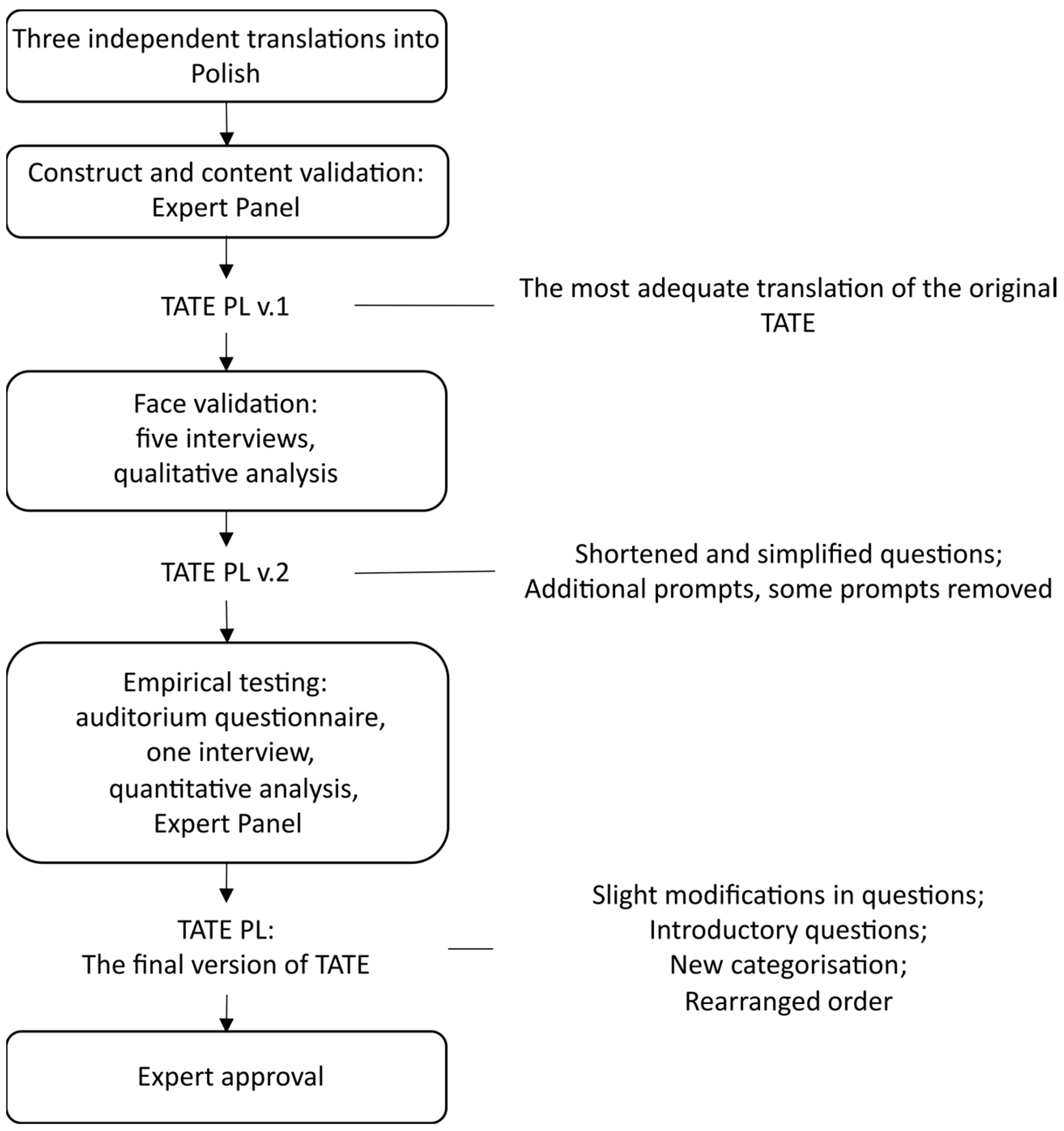
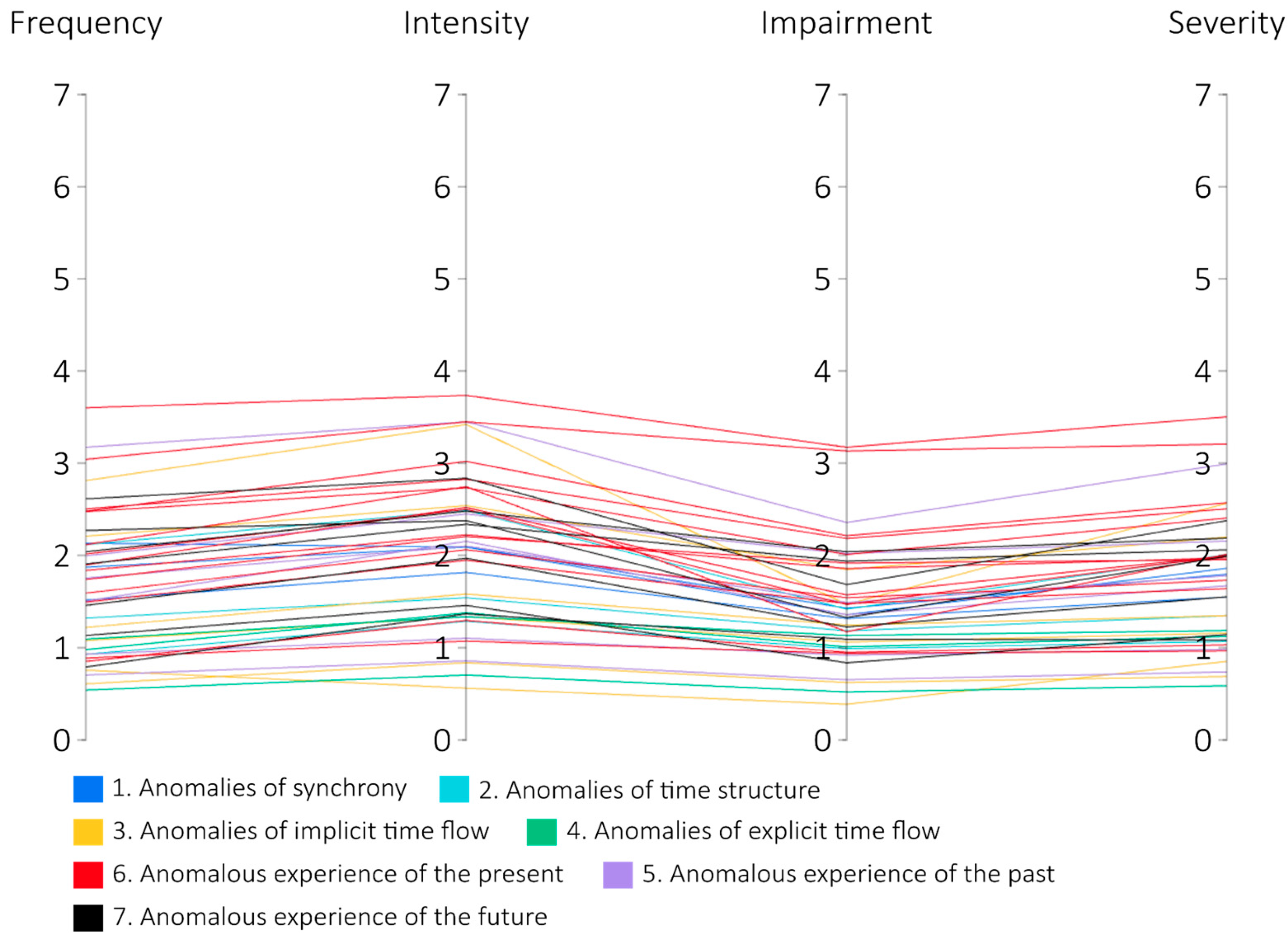
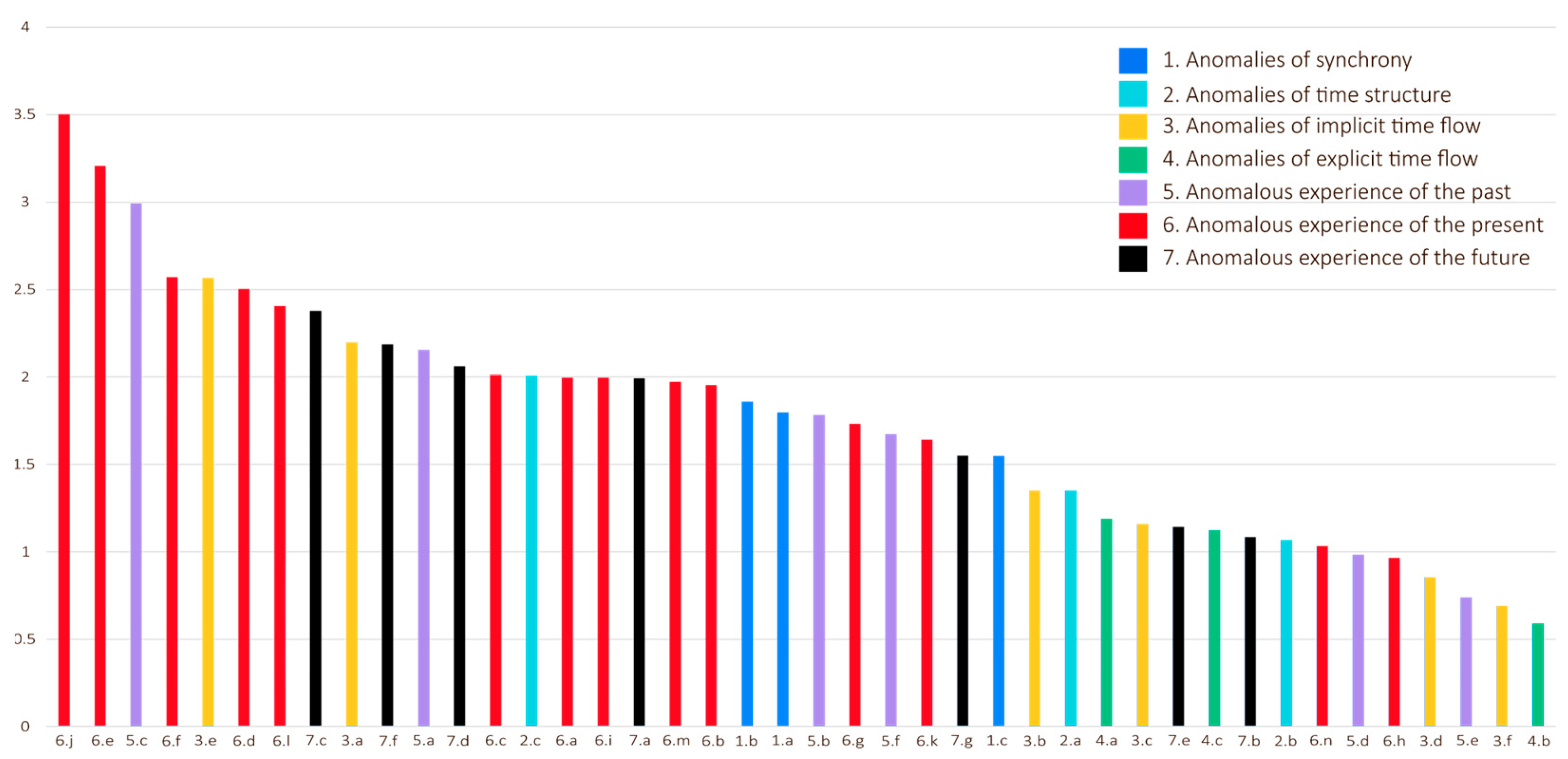
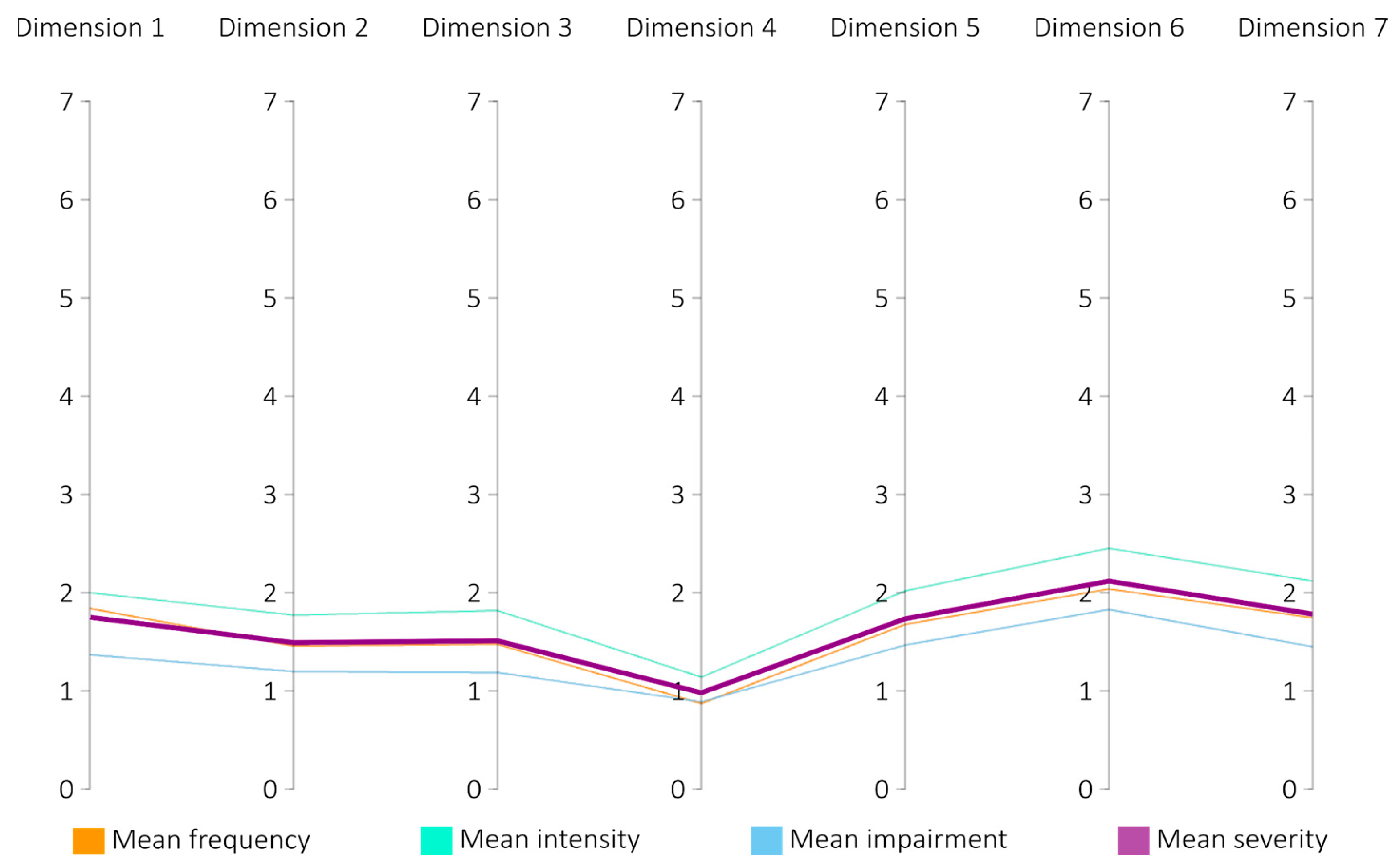
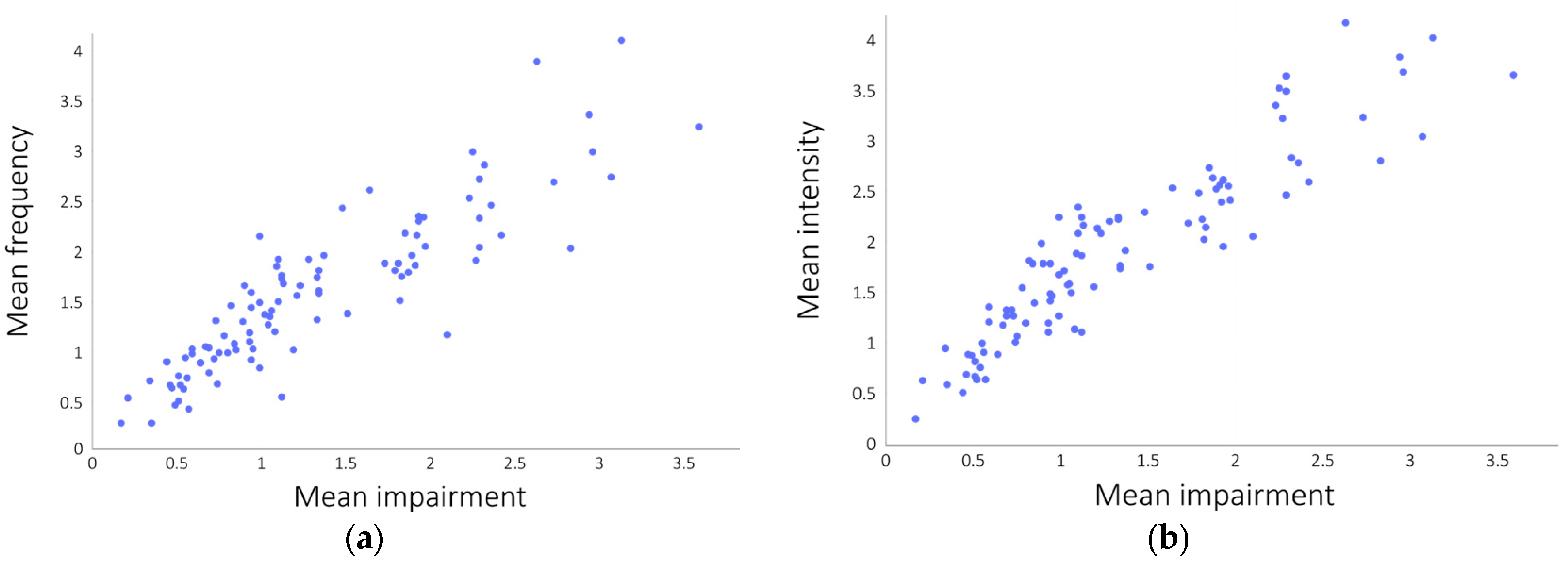
| Item 5.d Biographical Disintegration | Comments Supplied by Participants P2 and P4 (Translated from Polish) |
|---|---|
| In some cases, one may have the feeling that the most important life events are disconnected, as if the thread that keeps them together were missing. Does something like that happen to you? | [P2] Hardly understandable, I’m not sure what it is about, the most important events could be a wedding, a child, an illness, etc.—they are disconnected, what does aunt X’s divorce have to do with uncle Z’s death, if these events concern me only then there is a unifying thread, and if they involve the same person—e.g., marriage to Y, child to Y, divorce to Y. The question is not very specific. |
| [P4] I understand that there are milestones in life and there is no continuity of events. | |
| Do you feel that the choices, activities, jobs, and interests that you have experienced throughout your life are unrelated to each other, as if they were about different people? | [P2] Yes, I’ve realised recently—I lived my life not the way I wanted because I did not know how to live otherwise, I could not express desires, needs, that something is not right, etc. Childhood programming—it’s not mine, behaviour different from me, it’s the way I was bred, imprinted. |
| [P4] If I feel that some of my hobbies and job are very different from each other. | |
| Does it seem to you that the most important events of your past have happened a little at random, as if there were no history that connects them? | [P2] There are no coincidences, everything that happens, happens not by accident, although we perceive some situations as accidental. The question is complicated, not quite sure what it is about, not very specific. |
| [P4] If I feel that I have random events. |
| Item 4.b Time Reversal, Prompt 3 | Comments Supplied by Participants P1–P5 (Translated from Polish) |
|---|---|
| Do you feel that the things around you are going back to their starting point? | [P1] If I feel as if the situation, despite my efforts to solve it, returns to the same place where it started. |
| [P2] What does “things” mean? Is it phenomena, people or rather things—clothes? More probably phenomena, events. Weird question. | |
| [P3] When you throw something and it bounces back, it comes back to you. | |
| [P4] I understand it in a more positive sense, that an everyday routine reappears after a stressful time. | |
| [P5] I don’t know what things around me, what I could connect it all with, what might be going back. |
| Frequency | Intensity | Impairment |
|---|---|---|
| 0. It never happens. | 0. - | 0. - |
| 1. Rarely. | 1. I don’t feel it at all. | 1. It does not interfere with what I do. |
| 2. Sometimes. | 2. It’s very mild. | 2. Slight interference, I almost don’t notice it. |
| 3. Often. | 3. It’s mild but it’s there. | 3. Slight interference but I can still manage with everyday activities. |
| 4. Quite often. | 4. It’s pretty strong. | 4. It starts to interfere with my everyday activities. |
| 5. Very often. | 5. It’s strong. | 5. It interferes much with most of my everyday activities. |
| 6. Nearly always. | 6. It’s very strong. | 6. It interferes very much with almost all my everyday activities. |
| 7. It’s always like this. | 7. It’s unbearably strong. | 7. It interferes extremely with all my everyday activities. |
| ATE Dimension | Item | Frequency Mean (Me; Min; Max; IQR) | Intensity Mean (Me; Min; Max; IQR) | Impairment Mean (Me; Min; Max; IQR) | Severity Mean (Me; Min; Max; IQR) |
|---|---|---|---|---|---|
| 1. Anomalies of synchrony | 1.a | 1.872 (2.0; 0; 6; 1.0) | 2.092 (2.0; 0; 6; 2.0) | 1.429 (1.0; 0; 4; 1.0) | 1.798 (1.7; 0; 5.0; 1.0) |
| 1.b | 2.133 (2.0; 0; 6; 1.0) | 2.092 (2.0, 0, 6, 2.0) | 1.357 (1.0; 0; 4; 1.0) | 1.861 (1.8; 0; 5.0; 1.8) | |
| 1.c | 1.515 (1.0; 0; 7; 2.0) | 1.816 (2.0; 0; 6; 3.0) | 1.316 (1.0; 0; 6; 2.0) | 1.549 (1.7, 0; 6.3; 2.3) | |
| Summary | 1.840 (2.0; 0; 7; 2.0) | 2.000 (2.0; 0; 6; 2.0) | 1.367 (1.0; 0; 6; 1.0) | 1.736 (1.7; 0; 6.3; 1.7) | |
| 2. Anomalies of time structure | 2.a | 1.321 (1.0; 0; 6; 2.0) | 1.541 (1.0; 0; 7; 3.0) | 1.184 (1.0; 0; 6; 2.0) | 1.349 (1.3; 0; 6.3; 2.3) |
| 2.b | 0.929 (0.5; 0; 6; 1.3) | 1.286 (0.5; 0; 6; 2.0) | 0.990 (0.5; 0; 7; 2.0) | 1.068 (0.5; 0; 6.3; 1.8) | |
| 2.c | 2.117 (2.0; 0; 7; 2.0) | 2.490 (3.0; 0; 5; 1.0) | 1.418 (1.0; 0; 4; 1.0) | 2.009 (2.0; 0; 4.7; 1.5) | |
| Summary | 1.456 (1.0; 0; 7; 2.0) | 1.772 (2.0; 0; 7; 3.0) | 1.197 (1.0; 0; 7; 2.0) | 1.475 (1.3; 0; 6.3; 2.3) | |
| 3. Anomalies of implicit time flow | 3.a | 1.209 (0.0; 0; 7; 2.0) | 2.541 (3.0; 0; 7; 3.0) | 1.847 (1.0; 0; 7; 2.0) | 2.199 (2.0; 0; 7.0; 2.3) |
| 3.b | 2.119 (1.0; 0; 6; 2.0) | 1.582 (1.0; 0; 6; 3.0) | 1.245 (1.0; 0; 6; 2.0) | 1.349 (1.3; 0; 5.7; 2.3) | |
| 3.c | 1.077 (0.0; 0; 7; 2.0) | 1.337 (0.0; 0; 6; 2.0) | 1.061 (0.0; 0; 6; 2.0) | 1.158 (0.0; 0; 6.3; 2.0) | |
| 3.d | 0.757 (0.0; 0; 7; 1.0) | 1.013 (0.0; 0; 7; 2.0) | 0.789 (0.0; 0; 6; 1.0) | 0.853 (0.0; 0; 6.0; 1.6) | |
| 3.e | 2.811 (2.0; 0; 7; 2.5) | 3.418 (4.0; 0; 7; 3.0) | 1.469 (1.0; 0; 6; 1.0) | 2.566 (2.3; 0; 6.3; 1.8) | |
| 3.f | 0.607 (0.0; 0; 4.5; 1.0) | 0.837 (0.0; 0; 5; 2.0) | 0.622 (0.0; 0; 5; 1.0) | 0.689 (0.0; 0; 4.5; 1.3) | |
| Summary | 1.473 (1.0; 0; 7; 2.0) | 1.818 (2.0; 0; 7; 3.0) | 1.187 (1.0; 0; 7; 2.0) | 1.493 (1.3; 0; 7.0; 2.3) | |
| 4. Anomalies of explicit time flow | 4.a | 1.092 (0.0; 0; 7; 2.0) | 1.337 (0.0; 0; 7; 3.0) | 1.133 (0.0; 0; 7; 2.0) | 1.187 (0.0; 0; 7.0; 2.3) |
| 4.b | 0.541 (0.0; 0; 6; 1.0) | 0.704 (0.0; 0; 5; 1.0) | 0.520 (0.0; 0; 4; 1.0) | 0.558 (0.0; 0; 4.5; 1.1) | |
| 4.c | 0.980 (0.5; 0; 6; 2.0) | 1.378 (0.5; 0; 5; 3.0) | 1.010 (0.5; 0; 5; 2.0) | 1.122 (0.5; 0; 5.3; 2.0) | |
| Summary | 0.871 (0.0; 0; 7; 1.0) | 1.139 (0.0; 0; 7; 2.0) | 0.888 (0.0; 0; 7; 1.0) | 0.966 (0.0; 0; 7.0; 1.7) | |
| 5. Anomalous experience of the past | 5.a | 1.995 (2.0; 0; 7; 3.0) | 2.449 (2.0; 0; 7; 4.0) | 2.020 (2.0; 0; 7; 3.0) | 2.155 (2.0; 0; 7.0; 3.5) |
| 5.b | 1.755 (1.0; 0; 7; 3.0) | 2.102 (2.0; 0; 7; 3.0) | 1.490 (1.0; 0; 7; 2.0) | 1.782 (1.7; 0; 6.0; 2.7) | |
| 5.c | 3.173 (3.0; 0; 7; 2.5) | 3.449 (3.0; 0; 7; 3.0) | 2.357 (2.0; 0; 7; 3.0) | 2.993 (3.0; 0; 7.0; 2.7) | |
| 5.d | 0.929 (0.0; 0; 7; 2.0) | 1.102 (0.0; 0; 7; 2.0) | 0.918 (0.0; 0; 5; 2.0) | 0.983 (0.0; 0; 6.3; 1.7) | |
| 5.e | 0.704 (0.0; 0; 6; 1.0) | 0.857 (0.0; 0; 5; 2.0) | 0.653 (0.0; 0; 5; 1.0) | 0.738 (0.0; 0; 4.7; 1.3) | |
| 5.f | 1.505 (1.0; 0; 7; 2.0) | 2.153 (2.0; 0; 7; 4.0) | 1.357 (1.0; 0; 6; 2.0) | 1.672 (1.5; 0; 6.3; 2.4) | |
| Summary | 1.677 (1.0; 0; 7; 2.0) | 2.019 (2.0; 0; 7; 3.0) | 1.466 (1.0; 0; 7; 2.8) | 1.721 (1.3; 0; 7.0; 2.7) | |
| 6. Anomalous experience of the present | 6.a | 1.898 (1.5; 0; 7; 2.3) | 2.520 (2.0; 0; 7; 4.0) | 1.571 (1.0; 0; 7; 2.3) | 1.997 (2.0; 0; 7.0; 3.0) |
| 6.b | 1.740 (1.0; 0; 7; 3.0) | 2.204 (2.0; 0; 7; 4.0) | 1.918 (2.0; 0; 7; 3.0) | 1.954 (1.8; 0; 6.7; 3.0) | |
| 6.c | 2.117 (2.0; 0; 7; 2.0) | 2.745 (3.0; 0; 6; 2.0) | 1.173 (1.0; 0; 4; 0.0) | 2.012 (2.0; 0; 4.7; 1.4) | |
| 6.d | 2.505 (2.0; 0; 7; 2.0) | 2.827 (2.0; 0; 7; 3.0) | 2.184 (2.0; 0; 6; 2.0) | 2.505 (2.3; 0; 6.3; 2.2) | |
| 6.e | 3.041 (3.0; 0; 7; 3.5) | 3.449 (3.0; 0; 7; 1.0) | 3.133 (3.0; 0; 7; 2.0) | 3.207 (3.0; 0; 7.0; 2.4) | |
| 6.f | 2.480 (2.0; 0; 7; 2.4) | 3.020 (3.0; 0; 7; 2.0) | 2.214 (2.0; 0; 6; 2.0) | 2.571 (2.7; 0; 6.3; 1.8) | |
| 6.g | 1.592 (1.0; 0; 7; 2.0) | 2.061 (2.0; 0; 6; 3.0) | 1.541 (1.0; 0; 6; 2.0) | 1.731 (1.7; 0; 5.3; 2.7) | |
| 6.h | 0.888 (0.0; 0; 7; 1.0) | 1.071 (0.0; 0; 7; 2.0) | 0.939 (0.0; 0; 7; 2.0) | 0.966 (0.0; 0; 7.0; 1.7) | |
| 6.i | 2.015 (2.0; 0; 7; 2.0) | 2.500 (2.0; 0; 7; 3.0) | 1.469 (1.0; 0; 7; 1.0) | 1.995 (1.8; 0; 7.0; 1.5) | |
| 6.j | 3.602 (3.0; 0; 7; 4.0) | 3.735 (4.0; 0; 7; 2.3) | 3.173 (3.0; 0; 7; 2.0) | 3.503 (3.4; 0; 7.0; 3.0) | |
| 6.k | 1.495 (1.0; 0; 6; 2.0) | 1.949 (2.0; 0; 7; 3.0) | 1.480 (1.0; 0; 6; 2.3) | 1.641 (1.3; 0; 5.3; 2.7) | |
| 6.l | 2.474 (2.0; 0; 7; 2.4) | 2.735 2.0; 0; 7; 3.0) | 2.010 (2.0; 0; 7; 2.0) | 2.406 (2.3; 0; 7.0; 2.8) | |
| 6.m | 1.837 (1.5; 0; 7; 2.0) | 2.224 (2.0; 0; 6; 3.3) | 1.857 (2.0; 0; 6; 3.0) | 1.973 (1.7; 0; 6.3; 3.0) | |
| 6.n | 0.852 (0.0; 0; 7; 1.0) | 1.296 (0.0; 0; 6; 3.0) | 0.949 (0.0; 0; 6; 1.3) | 1.032 (0.0; 0; 5.2; 2.0) | |
| Summary | 2.038 (2.0; 0; 7; 3.0) | 2.448 (2.0; 0; 7; 4.0) | 1.829 (1.0; 0; 7; 3.0) | 2.107 (2.0; 0; 7.0; 3.3) | |
| 7. Anomalous experience of the future | 7.a | 2.270 (2.0; 0; 7; 3.0) | 2.378 (2.0; 0; 7; 4.0) | 1.327 (1.0; 0; 6; 2.0) | 1.991 (2.0; 0; 5.3; 3.0) |
| 7.b | 0.791 (0.0; 0; 7; 1.0) | 1.367 (0.0; 0; 7; 3.0) | 1.092 (0.0; 0; 7; 2.0) | 1.083 (0.0; 0; 6.3; 2.0) | |
| 7.c | 2.612 (2.0; 0; 7; 3.5) | 2.837 (3.0; 0; 7; 2.0) | 1.684 (1.0; 0; 5; 2.0) | 2.378 (2.3; 0; 5.7; 2.0) | |
| 7.d | 1.908 (1.0; 0; 7; 3.0) | 2.337 (2.0; 0; 7; 4.0) | 1.939 (2.0; 0; 7; 3.0) | 2.061 (1.7; 0; 7.0; 3.3) | |
| 7.e | 1.133 (1.0; 0; 7; 2.0) | 1.459 (1.0; 0; 7; 2.0) | 0.837 (1.0; 0; 6; 1.0) | 1.143 (1.0; 0; 6.3; 2.0) | |
| 7.f | 2.041 (2.0; 0; 6; 3.0) | 2.480 (2.0; 0; 6; 4.0) | 2.041 (2.0; 0; 6; 3.0) | 2.187 (2.0; 0; 5.7; 3.7) | |
| 7.g | 1.459 (1.0; 0; 7; 2.0) | 1.969 (2.0; 0; 7; 3.0) | 1.224 (1.0; 0; 6; 2.0) | 1.551 (1.5; 0; 6.3; 2.3) | |
| Summary | 1.745 (1.0; 0; 7; 2.0) | 2.118 (2.0; 0; 7; 3.0) | 1.449 (1.0; 0; 7; 2.0) | 1.771 (1.7; 0; 7.0; 2.8) |
| Scale | Cronbach’s α, N = 98 |
|---|---|
| Frequency | 0.916 |
| Intensity | 0.936 |
| Impairment | 0.947 |
Disclaimer/Publisher’s Note: The statements, opinions and data contained in all publications are solely those of the individual author(s) and contributor(s) and not of MDPI and/or the editor(s). MDPI and/or the editor(s) disclaim responsibility for any injury to people or property resulting from any ideas, methods, instructions or products referred to in the content. |
© 2024 by the authors. Licensee MDPI, Basel, Switzerland. This article is an open access article distributed under the terms and conditions of the Creative Commons Attribution (CC BY) license (https://creativecommons.org/licenses/by/4.0/).
Share and Cite
Szuła, A.; Moskalewicz, M.; Stanghellini, G. Transdiagnostic Assessment of Temporal Experience (TATE) in Mental Disorders—Empirical Validation and Adaptation of a Structured Phenomenological Interview. J. Clin. Med. 2024, 13, 4325. https://doi.org/10.3390/jcm13154325
Szuła A, Moskalewicz M, Stanghellini G. Transdiagnostic Assessment of Temporal Experience (TATE) in Mental Disorders—Empirical Validation and Adaptation of a Structured Phenomenological Interview. Journal of Clinical Medicine. 2024; 13(15):4325. https://doi.org/10.3390/jcm13154325
Chicago/Turabian StyleSzuła, Anastazja, Marcin Moskalewicz, and Giovanni Stanghellini. 2024. "Transdiagnostic Assessment of Temporal Experience (TATE) in Mental Disorders—Empirical Validation and Adaptation of a Structured Phenomenological Interview" Journal of Clinical Medicine 13, no. 15: 4325. https://doi.org/10.3390/jcm13154325





